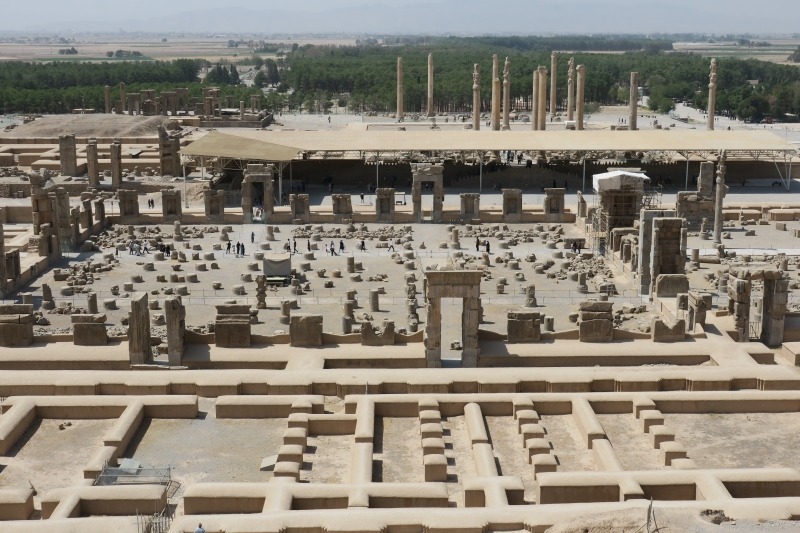Shiraz
Shiraz is situated in south west of Iran and is the capital of the province of Fars. Among Iran destinations, Shiraz enjoys of particular importance as the greatest Persian Empire formed close to Shiraz and spanned for many centuries. As a result, the grand cities of Pasargadae and Persepolis were established with the most splendid palaces, gardens, halls, and Royal roads. Then civilization was improved as it is observable in development of architecture, flourishing of paintings, sculpturing and simulating of arts and in a word the development of culture. The remained inscriptions of ancient Persia are significant testimonies of Iran’s great civilization.

Shiraz became the leading centre for literary and art from 13th century for many years because of the support of the ruler and the presence of many poets like Hafez & Sa’adi, scholars and artists at that time. Shiraz is one of 4 major cities along Iran Classic Route and the hub for visiting the ancient Persia and Persia Empires. Shiraz is a magnificent destination for Iran cultural tours and there are many Iran adventure tours around Shiraz as well. Shiraz is famous for its wine too. There is a story about how the wine was made. According to Madam Jane Dieulafoy’s writings, it is said that King Jamshid liked grapes more than other fruits and for this reason he put a lot of grapes in big crocks for using during winter and buried the crocks inside the ground. After a while, he asked to open the crocks and bring him some grapes. Surprisingly they saw all the grapes have been spoiled. The king was so unhappy and asked to close the pots and wrote on the crocks “poison”. One of the maiden who had a very serious headache and disappointed from treatment, wanted to end her life; so drank a glass of the poison. She fainted for a while and after waking up, she didn’t suffer from headache any more. So she drank the poison whenever she felt sick till it was finished. One day the King found the crocks of poison empty and asked to investigate about that. The maiden confessed and the king ordered to prepare that to taste. Next year, the King and his courtiers drank the drinking juice and found it so delicious and tasty. So they called it “delicious poison”.
History of Shiraz
Shiraz is one of the ancient cities dates from 6500 years ago, when the early civilization was existed. Shiraz was called Tirazis in ancient time as mentioned in Elamite inscriptions obtained in 2000 BC which it is a punctual reference indicating the antiquity of Shiraz city. In 2017, the archeologists excavated Postchi hills close to Shiraz and found many evidences from prehistory (Neolithic) and history era.
Topography of Shiraz
Shiraz is located in the south of Iran and surrounded by ancient Persia civilizations; Pasargadae and Persepolis are in the northeast, Bishapur in the northwest, Firuzabad in the south and Sarvestan in the east. Shiraz is constructed on a green plain and in the foot of Zagros mountains at 1500m above sea level.
Shiraz Climates
Shiraz lies on about 1500 m above sea level at the foot of Zagros mountain ranges and is surrounded by mountains in north and west. its climate is steppe so that it is dry and hot during the summer and very cold and wet during the winter.
Attractions of Shiraz
The ancient city of Shiraz has many top attractions from different periods including historical monuments, architectural citadels, mausoleums, mosques, Persian gardens, natural sites, scenic landscapes.
Quran Gate is a historical gate located in the northeast of Shiraz between Baba Kouhi and Chehel Maqahm mountains. Quran gate was built in Buyid dynasty but sustained many damages during Zand dynasty; therefore, it was renovated and a small room added to the top of gate where handwritten Qurans by Sultan Ibrahim Bin Shahrukh Gurekani were kept. These Qurans are known as Hifdah-Man. There is a belief that the travelers who starts their trip and passes underneath of this gate, will receive the blessing of the Holy Book. The Qurans moved to Pars museum in Shiraz in 1937 and remained until today.
Mausoleum of Hafez locally known as HAFEZIEH is an architectural tomb for the greatest poet of 14th century. It consists of a tomb and memorial halls, garden and open pavilion structure. The present structures have been designed and built by the French architect, Andre Godard in 1935. It is located in Shiraz, Hafezieh is one of the most attractive sites in Iran.
Karim Khan citadel or Arg-e Karim Khan is located in the central part of Shiraz, built in the early of the Zand dynasty in 1697and named after Karim Khan Zand and of course his living place when he selected Shiraz as capital. The shape of this fortress is rectangular and resembles medieval fortress. Karim Khan citadel is a combination of residential and military architectures and consists of porches, various rooms designed by shirazi-style patterns and marbles and the courtyard decorated by fountains, flower gardens and fruit trees. There are 6 rooms and 1 porch in the north, south and west sides of the citadel and the bathhouse and kitchen are in the east side. All the complex is surrounded by high brick walls and 4 circular towers in the corners. The height of each tower is 14m and the height of wall is 12m. it is interesting to know that one of the towers has a lean to one side which remind us the leaning tower of Pisa.
The citadel had different functions in every dynasty. It was the living place of Karim Khan and in Qajar time it was used as residential place for local rulers and as a prison in Pahlavi dynasty. Karim Khan citadel was registered as Iran National Heritage in 1972.
Vakil Bazaar is the major market in Shiraz which located in the historical part of the city. Vakil Bazaar was built in the 11th century by the Buwayhids. It was called after Karim Khan Zand in the 18th century. Vakil Bazaar contains many courtyards, bath houses, caravanserais and old shops trading Persian rugs, spices, antiques and handcrafts made of copper.
Vakil Bath house is a public bath dating back to Karim Khan Zand’s reign, 18th century. It is located in the historical part of Shiraz, close to Vakil Bazaar and in the west side of Vakil mosque. Vakil bath house is a masterpiece of Iranian architecture with outstanding paintings on the walls and ceilings. In fact, it is one of the few public baths in Iran is designed by architectural decorations and paintings. The themes of paintings have been taken from Persian mythologies and epics which form the main part of Iran culture. Vakil Bath like other old baths is not a normal bath for washing and cleaning but they were used for special ceremonies such as marriage proposal, baby shower (for infants for the first time) and marriage traditions. However, these traditions are not held in the baths anymore.
Nasir-ol-Molk mosque also known as the Pink mosque is one of the beautiful traditional mosques of Iran destinations situated in Shiraz. It was built in Qajar dynasty by the order of the Late Hassan Ali Nasir al-Molk who was one of the Lords of Shiraz. Nasir-ol-Molk mosque was designed by Mohammad Hassan-e Memar, the Iranian architect who designed and built Eram Garden earlier. The best time to visit this outstanding mosque is morning time when the sun rises and reflects the pink colors inside the mosque.
Mausoleum of Sa’adi also known as Sa’adieh is the tomb and a mausoleum dedicated to Sa’adi, the Persian poet. It is located in Shiraz and is one of the most important highlights of Iran destinations. This mausoleum was a Khanqah, a place where was specifically designed for gatherings of Sufi brotherhood for ritual and spiritual retreat. For the first time, the tomb of Sa’adi was built in the 13th century by Shams al-Din Juvayni. It was destroyed in the 17th century and the mausoleum was built during Karim Khan’s reign in two floors of brick and plaster. The current mausoleum of Sa’adi was designed by the Iranian architect Mohsen Foroughi inspired by Chehel Sotun and built between 1950-1952.
